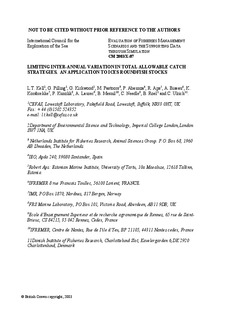| dc.contributor.author | Kell, Laurence T. | |
| dc.contributor.author | Pilling, Graham | |
| dc.contributor.author | Kirkwood, Geoffrey P. | |
| dc.contributor.author | Pastoors, Martin | |
| dc.contributor.author | Abaunza, Pablo | |
| dc.contributor.author | Aps, Robert | |
| dc.contributor.author | Biseau, Alain | |
| dc.contributor.author | Korsbrekke, Knut | |
| dc.contributor.author | Kunzlik, Philip | |
| dc.contributor.author | Laurec, Alain | |
| dc.contributor.author | Mesnil, Benoit | |
| dc.contributor.author | Needle, Coby L. | |
| dc.contributor.author | Roel, Beatriz | |
| dc.contributor.author | Ulrich, Clara | |
| dc.date.accessioned | 2012-11-06T20:08:53Z | |
| dc.date.available | 2012-11-06T20:08:53Z | |
| dc.date.issued | 2003 | |
| dc.identifier.citation | This report is not to be cited without prior reference to the authors | no_NO |
| dc.identifier.uri | http://hdl.handle.net/11250/106505 | |
| dc.description.abstract | This study evaluated through simulation management strategy that stabilise catch levels by setting
bounds on the inter-annual variability in Total Allowable Catches (TACs). An integrated modelling
approach was used, which modelled both the ‘real’ and observed systems and the interactions between
all system components. The modelling framework therefore allowed evaluation of the robustness of
candidate management strategies to both the intrinsic properties of the systems, and the ability to
observe, monitor, assess and control them. Strategies were evaluated in terms of level of risk
(measured as the probability of spawning stock biomass falling below the biomass limit reference
level for the stock) and cumulative yield.
The simulation approach used provides a powerful tool for the examination of the performance of
candidate management strategies. It has shown that better management is not necessarily going to be
achieved by improving the assessement, since even with a perfect assessment (where the simulated
working group knew stock status perfectly) stocks may crash at fishing levels that standard stochastic
projections would suggest were safe. Also explicitly modelling the assessment process can result in
quite different outcomes than those predicted by the simple projection traditionally used by stock
assessment working groups. This is because the simple projection assumes that the status of the stock
in the current year is known without error and that the target fishing mortality can be achieved
without error. However, in practice the assessment is based on last years data and the effect of any
management measure on SSB is only manifest, following the implementation of the quota, at the end
of the following year.
The choice of target and fishing mortality levels and minimum stock levels results from ICES
interpretation of the precautionary approach. This lead to the definition of fishing mortality and
biomass reference points that are intended to prevent over-fishing and to trigger recovery plans when
a stock is overfished respectively. Although, fishing mortality and biomass reference points were
originally intended to be independent, a fishing mortality level implies a corresponding biomass level.
In the case of saithe a fishing mortality of 0.40 (i.e. the FPA level) would drive the stock to Blim,
suggesting that the choice of biomass and target reference points are not consistent for this stock. | no_NO |
| dc.language.iso | eng | no_NO |
| dc.publisher | ICES | no_NO |
| dc.relation.ispartofseries | ICES CM Documents;2003/X:7 | |
| dc.subject | cod | no_NO |
| dc.subject | torsk | no_NO |
| dc.subject | haddock | no_NO |
| dc.subject | hyse | no_NO |
| dc.subject | whiting | no_NO |
| dc.subject | hvitting | no_NO |
| dc.subject | saithe | no_NO |
| dc.subject | sei | no_NO |
| dc.subject | hake | no_NO |
| dc.subject | lysing | no_NO |
| dc.subject | catch strategy | no_NO |
| dc.subject | fangststrategi | no_NO |
| dc.subject | stock assessment | no_NO |
| dc.subject | bestandsberegning | no_NO |
| dc.subject | management advice | no_NO |
| dc.subject | forvaltningsråd | no_NO |
| dc.title | Limiting inter-annual variation in total allowable catch strategies. An application to ICES roundfish stocks | no_NO |
| dc.type | Working paper | no_NO |
| dc.subject.nsi | VDP::Agriculture and fishery disciplines: 900::Fisheries science: 920::Catch: 925 | no_NO |
| dc.subject.nsi | VDP::Mathematics and natural science: 400::Geosciences: 450::Oceanography: 452 | no_NO |
| dc.subject.nsi | VDP::Agriculture and fishery disciplines: 900::Fisheries science: 920::Fish health: 923 | no_NO |
| dc.subject.nsi | VDP::Social science: 200::Library and information science: 320::Knowledge retrieval and organization: 323 | no_NO |
| dc.source.pagenumber | 21 s. | no_NO |
